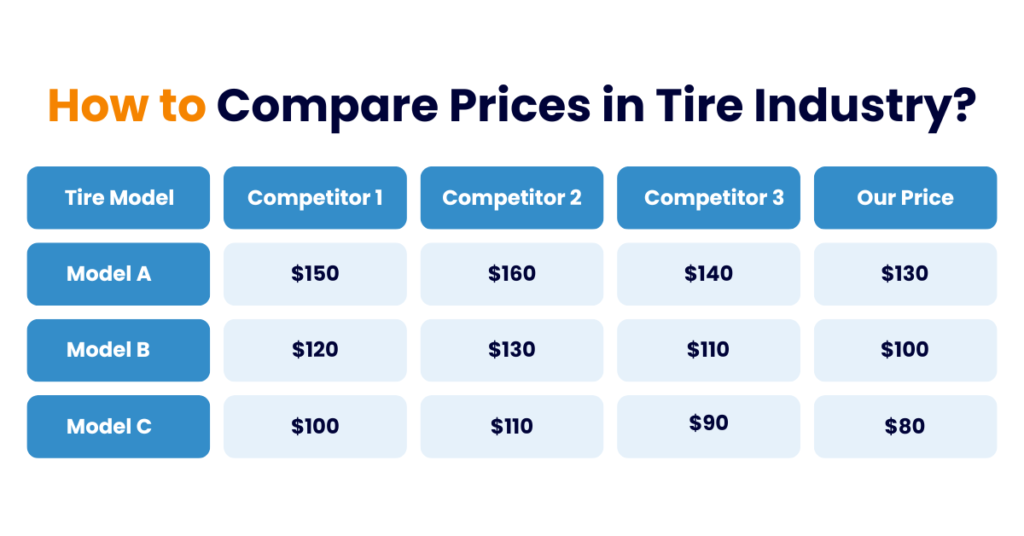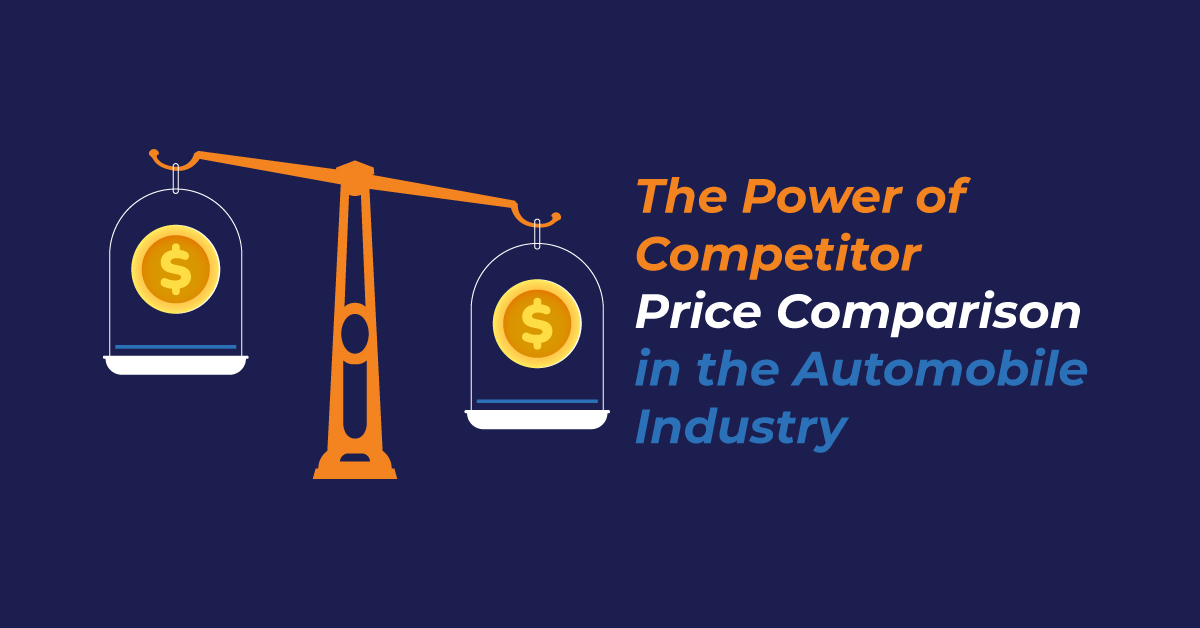An effective pricing strategy can help a company in selling its products in a highly competitive market to gain a profit. The pertinent question is what is a pricing strategy? It is an approach for finding the right/ competitive price for a product or service in a specific market. Every management follows certain strategies in an organization and pricing strategy is one of them. The goal of a company is to maximize turnover. For coming up with an effective competitor price comparison plays a crucial role.
For optimizing the profit, the right strategy for price setting is required. It is only after collecting competitor pricing data, and price comparison, an automobile business can develop a great strategy for optimizing its profit margin. A business might use various combinations of pricing strategies for increasing sales and paving the way for success in the long run.
How Do You Compare Prices with Competitors in the Tire Industry?
The first step in setting the right price for automotive parts is price comparison. Competitor pricing analysis is the process of looking for competitors for understanding their strengths and weaknesses. The insight is then used for improving the pricing decisions.
For instance, there exist three distinct tire models, each offering varying prices from different competitors. By conducting a competitive price comparison, we can develop a strategic pricing approach through a comparative assessment of our competitors’ pricing.

Here’s a look at how to perform auto parts price comparisons with competitors:
1. Identify the Competitors
For tire price comparison, you must begin with Google as consumers start their shopping from there. A quick search will help in narrowing down the competitors. Type the name of your product and jot down the names that appear. These are the same results that the prospects will see. You can also use SEO tools for finding competitors based on the specific keywords.
2. Categorize the Competitors
For effective competitor price comparison, consider only those competitors that rank high for the product keyword. It is important to keep a track of both search and keyword-based competitors for competitor price monitoring. Having a competitive advantage over other automotive parts suppliers helps in beating them in sales and profit. Categorize the competitors into main and secondary competitors. Further, break them into search and price competitors. All these categories will help in customizing the pricing strategy.
3. Analyze Competitor Prices
The main aim of price comparison is to optimize own prices. It can offer a significant benefit when you know how competitors price their products. With the help of a price comparison tool, you can find out about the competitor’s pricing and if there is a particular pattern or strategy. The idea is to understand how they price and come up with an effective pricing strategy for your product.
What Can Automobile Business Learn from Price Comparison Sites?
Though price comparison sites seem helpful to consumers, they can also help automobile businesses in analyzing the competition and target the offers efficiently. A Price comparison website can help in the following ways:
1. Find out who is selling what?
Price comparison websites enable a business to compare the suppliers of automotive parts and offer a snapshot of the market. It is easy to find out the direct competitors and find out what each of them is selling. It is worth finding what the competitors are selling and at what price. It helps a business make lucrative decisions.
2. Stay up-to-date on Pricing
Sellers keep on adjusting their prices constantly to stay ahead of the game. A business can’t afford to stay ignorant of the prices offered by the competitors. It is crucial to keep an eye on the prices of the competitors with competitor price monitoring. You may not be able to compete on the basis of price with huge firms, but it will at least help in ensuring that the prices are competitive.
3. Hot Products and Trends
To begin with many price comparison sites pick the best selling products and feature them on the home page. Also, by spotting trends, an automobile business can make sure to stock the right products, promote them significantly, and price them competitively to benefit from the rising demand.
Analyzing the competitors on the price comparison sites also offers an opportunity to check the gaps. Furthermore, the tools help in identifying if you have something unique to offer to stand out in the crowd. You can compare the unique selling points to ensure that you are distinct.
4. Research Online Platforms
Online platforms have revolutionized the way businesses operate, and they offer a wealth of information for price comparison purposes. Utilize search engines, e-commerce websites, and online marketplaces to gather data on your competitors’ tire prices. Take note of their pricing strategies, discounts, and any special offers they provide.
5. Utilize Price Comparison Tools
In today’s digital era, there are a range of price comparison tools and software is available to assist businesses in monitoring competitor prices. These tools automatically collect data from various sources, saving you time and effort. Some popular options include Google Shopping, WebDataGuru and PriceIntelGuru. Explore and invest in tools that align with your specific needs and budget.
Pricing Strategies for Automobile Sector
1. Penetration and Psychological Pricing Strategies
For gaining a significant market share, automobile business can use the penetration pricing strategy. The aim is to set- up a customer-based price for the products. It is implemented by offering free or low priced products for a limited period of time. This product later comes to the market with a revised version as a premium product and price hike. It helps in winning the trust of the customers of a new brand.
2. Product Line and Economy Pricing Strategy
This type of strategy offers an option to upgrade by choosing higher-value packs. Consumers are made to compare the packages and choose a wise and cost-effective product. The product line strategy also helps bring a product to the spotlight that has low visibility/ recognition.
The economy pricing strategy makes use of low marketing costs in product promotion. A good example of this pricing strategy is promoting only a particular range of products which helps in gaining quick attention among consumers.
3. Customer Value-based Strategy
It is one of the effective pricing strategies that focus on the customer-perceived value of a product. It is completely based on how customers value the product and if they find it worth buying. Companies that offer unique and high-value products go for this strategy. Value-based pricing strategy enables a manufacturing company to extend the life cycle of the existing product and create a great bond with value-added suppliers.
Read Also: 9 Types of Product Pricing Strategies
Benefits of Competitor Price Comparison
Competitive Advantage:
In any business you need to have a sharp eye for your competitor moves. And by regularly comparing prices with your competitors, you gain valuable insights into their pricing strategies. Then again, this knowledge allows you to adjust your own prices accordingly, ensuring that you remain competitive in the market. Staying ahead of the competition gives you a distinct advantage when it comes to attracting customers and generating sales.
Precise Pricing Decisions:
As explained earlier, price comparison helps you make informed pricing decisions based on market trends and competitors’ actions. Now, by analyzing the pricing data, you can identify pricing gaps, and opportunities for discounts or promotions, and adjust your prices to maximize profitability in way that is beneficial for you.
Better Sales and Revenue:
Every business is here to make profits, that is the marketing lesson 101. And effective price comparison helps you to offer competitive prices to customers, making your products more appealing compared to your competitors. Additionally, customer perception plays a greater role here. When the shoppers or end users perceive that they are getting the best value for their money, they are more likely to choose your tire products over the others.
Long-lasting Customer Loyalty:
You must understand that price comparison helps you get the market dynamics and respond to customer preferences in an effective manner. By offering competitive prices, you can attract new customers and retain existing ones. Customers appreciate transparency and value for their money, and when they consistently find your prices competitive, it builds trust and loyalty towards your brand.
Get Improved Profit Margins:
Monitoring competitor prices enables you to identify opportunities to optimize your pricing structure. You can identify areas where you may be pricing too low or too high and make adjustments accordingly. By finding the right balance between pricing and profitability, you can improve your profit margins and overall financial performance.
Enhanced Market Positioning:
Regularly comparing prices with competitors allows you to position your brand effectively in the market. You can identify your unique selling propositions and highlight them in your marketing efforts. If you consistently offer competitive prices or provide additional value through services or promotions, you can establish your brand as a go-to choose for customers seeking quality tires at reasonable prices.
Optimized Strategic Decision-Making:
Price comparison not only helps with immediate pricing decisions but also contributes to long-term strategic planning. By understanding the pricing strategies of your competitors, you can identify emerging market trends, anticipate pricing fluctuations, and adapt your business strategies accordingly. This proactive approach positions you for sustainable growth in the tire industry.
Better Negotiations with Suppliers:
Armed with knowledge about competitor prices, you can negotiate better deals with suppliers. When you can demonstrate that you are aware of market pricing trends and the prices offered by competitors, suppliers are more likely to offer competitive rates and favorable terms. This can lead to cost savings and improved profitability for your business.

Make Your Tire Business Skyrocket with WebDataGuru
When a pricing system consists of detailed pricing analytics, it improves customer satisfaction. The pricing system helps in achieving optimum profit. Competitor price comparison tools come in handy while collecting and analyzing the prices of the competitors in the automobile industry. It ultimately enables your business in choosing the right strategy and setting accurate price point.
Take action now by implementing these proven strategies and tools to compare prices effectively. Start reaping the benefits of a well-informed pricing strategy and position your business for long-term success.
It’s time to drive your tire business to new heights. Book a demo now and be the leader in the industry with us!

Recent Comments